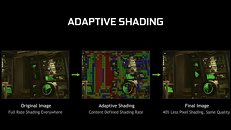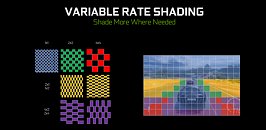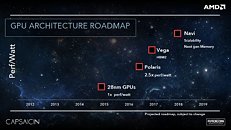Monday, March 4th 2019

AMD Patents Variable Rate Shading Technique for Console, VR Performance Domination
While developers have become more and more focused on actually taking advantage of the PC platform's performance - and particularly graphical technologies - advantages over consoles, the truth remains that games are being optimized for the lowest common denominator first. Consoles also share a much more user-friendly approach to gaming - there's no need for hardware updates or software configuration, mostly - it's just a sit on the couch and leave it affair, which can't really be said for gaming PCs. And the console market, due to its needs for cheap hardware that still offers performance levels that can currently fill a 4K resolution screen, are the most important playground for companies to thrive. Enter AMD, with its almost 100% stake in the console market, and Variable Rate Shading.
As we've seen with NVIDIA's Turing implementation for Variable Rate Shading, this performance-enhancing technique works in two ways: motion adaptive shading and content adaptive shading. Motion adaptive shading basically takes input from previous frames in order to calculate which pixels are moving fast across the screen, such as with a racing perspective - fast-flying detail doesn't stay focused in our vision so much that we can discern a relative loss in shading detail, whilst stationary objects, such as the focused hypercar you're driving, are rendered in all their glory. Valuable compute time can be gained by rendering a coarse approximation of the pixels that should be in that place, and upscaling them as needed according to the relative speed they are moving across the frame. Content adaptive shading, on the other hand, analyzes detail across a scene, and by reducing shading work to be done across colors and detail that hasn't had much movement in the previous frame and frames - saves frame time.This particular technology is one of those that makes all the sense for AMD to implement in their architecture, because these are sure ways of gaining performance and frametime levels with minimal compromises in image quality. This is a particularly important aspect in the svelte GPU world of consoles - yes, performance is extracted much closer to the metal, but remember, an Xbox One X is currently rendering full 4K games with a GPU that's much closer to an RX 580 in performance than to an RTX 2070 - a graphics card that can't run Anthem at the same 4K Medium settings that the Xbox console can (without RTX). NVIDIA themselves have said that in certain scenarios, the GTX 1660 Ti delivers 1.5x higher frame rates compared with the GTX 1060 - solely due to the application of VRS.Not only in letting consoles achieve much higher pixel density does this tech work, but it can also allow for a performance democratization for VR, where higher frames per second are necessary to offset some side effects of that kind of gaming - and where Sony seems to be betting on as an evolutionary focus in the years to come. It remains to be seen whether or not AMD is able to implement this tech for Navi, but the upside is too great, and the patent too timely, for it not be deployed - at least in AMD's custom silicon for the next generation of consoles.
Sources:
AMD Variable Rate Shading Patent, PCGamesN
As we've seen with NVIDIA's Turing implementation for Variable Rate Shading, this performance-enhancing technique works in two ways: motion adaptive shading and content adaptive shading. Motion adaptive shading basically takes input from previous frames in order to calculate which pixels are moving fast across the screen, such as with a racing perspective - fast-flying detail doesn't stay focused in our vision so much that we can discern a relative loss in shading detail, whilst stationary objects, such as the focused hypercar you're driving, are rendered in all their glory. Valuable compute time can be gained by rendering a coarse approximation of the pixels that should be in that place, and upscaling them as needed according to the relative speed they are moving across the frame. Content adaptive shading, on the other hand, analyzes detail across a scene, and by reducing shading work to be done across colors and detail that hasn't had much movement in the previous frame and frames - saves frame time.This particular technology is one of those that makes all the sense for AMD to implement in their architecture, because these are sure ways of gaining performance and frametime levels with minimal compromises in image quality. This is a particularly important aspect in the svelte GPU world of consoles - yes, performance is extracted much closer to the metal, but remember, an Xbox One X is currently rendering full 4K games with a GPU that's much closer to an RX 580 in performance than to an RTX 2070 - a graphics card that can't run Anthem at the same 4K Medium settings that the Xbox console can (without RTX). NVIDIA themselves have said that in certain scenarios, the GTX 1660 Ti delivers 1.5x higher frame rates compared with the GTX 1060 - solely due to the application of VRS.Not only in letting consoles achieve much higher pixel density does this tech work, but it can also allow for a performance democratization for VR, where higher frames per second are necessary to offset some side effects of that kind of gaming - and where Sony seems to be betting on as an evolutionary focus in the years to come. It remains to be seen whether or not AMD is able to implement this tech for Navi, but the upside is too great, and the patent too timely, for it not be deployed - at least in AMD's custom silicon for the next generation of consoles.



39 Comments on AMD Patents Variable Rate Shading Technique for Console, VR Performance Domination
It's mobile. It's a great upgrade from phones without the disadvantages of a normal console. And compared to something like Xbox One S or PS4, it's actually not a bad performer.
And as a gaming gadget at home? Imagine you don't want a TV and you don't own a monitor. Excellent. Imagine you don't live alone and you can't access the TV as frequent as you'd like - fantastic.
I don't like the game choice on Switch, but the hardware is great. It's precisely what I'd like the "streaming-focused" next-gen Xbox to look like. Fingers crossed.Does a laptop count as a PC? And what about tablets? :-)
When it comes to Pascal, I believe FP16 is crippled to 1/64 FP32, NVIDIA somehow disabled FP16 to FP32 promotion, might be wrong, though.
I remember taking a gaming development class and another one for game modeling, and for example; one of the most essential best practices was minimizing the polygon count to get the job done, and long story short, you would be surprised how easy it is to do a sloppy job that takes up twice or 3 times the polygons. Basically by the end of that class we were able to model the same things but with atleast half the number of polygons. This concept extends further to much of the design process and not just the polygons. 2% extra details for a 20-30% performance impact is just sloppy work. Zelda breath of the wild is a perfect representation of what is possible with proper game design.
Monitors are disappearing from most homes. We have to accept that.Why would Switch "destroy" other consoles? Of course it's made for a particular customer. But if you think it's a small niche, you're greatly mistaken.
In 2018 Nintento sold 17 mln Switches. This means they've almost matched PS4 (18mln). They have 35% console market share.
In case you don't know, there are around 40 mln desktop graphics cards sold yearly. This means, for example, that Nintento Switch beat AMD Radeon (by a decent margin).
But more importantly: what's with that war terminology? Don't people know other words these days? What happened to "supersede", "supplant" or even "replace"? :-)
(you might understand this then)
IT MAKS U SEAM STOOPID LOL, KTHXBAI DOOD.
Certain scenario for nV means sponsored game on already optimized system and with specific driver. Probably they add weather into the mix too. Running such a system in Siberia will definitely get more FPS than running it in a random home.
The visual degradation we see here is of another level:
> first we add loads of insignificant detail
> then we blur it up with temporal aa and resolution scaling, and now variable rate shading.
end result: noticeable dog poo.
Its a strange, strange world.
As far as switch selling 17 million, you have to take in to account ps4 it towards the end of its life span, so PS4 still sold more towards end of its life span then Nintendo. Nintendo does not have an overall 35% market share, common! Like I said it has its place and good for Nintendo but it won't be in the league of PlayStation. Rightly so, because its not geared towards that kind of gaming, Nintendo is happy with what they are doing and there is nothing wrong with that. No one is arguing switch is not a good product, but it shouldn't be compared to play stations.
I'm building a (light) gaming system with him, just to allow his parents to watch Dr Who.
As for any console...I still have my PS2, 158 million sold, Sony got something right back in 2000.